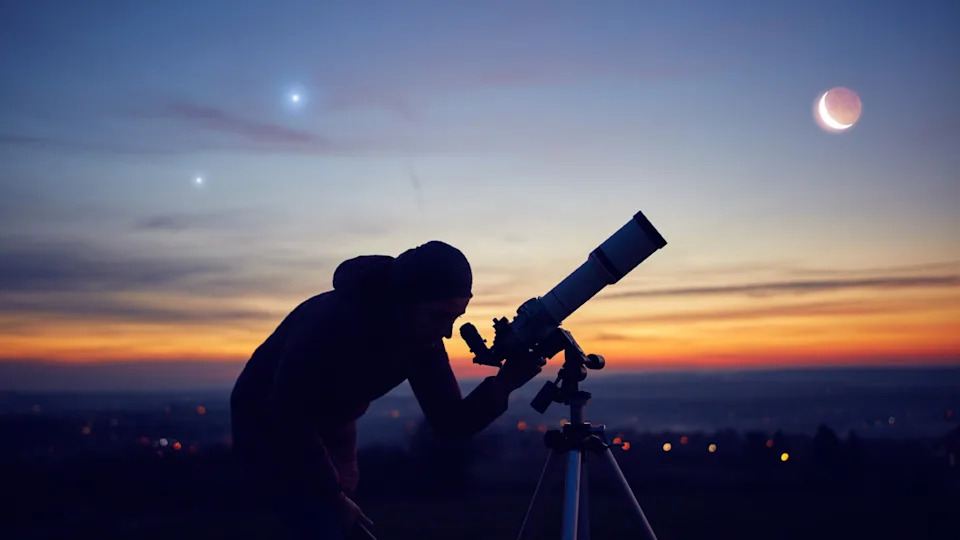As July 2025 unfolds, stargazers may find it a challenging month for planet viewing, yet it offers unique opportunities to observe some of the solar system’s most captivating celestial bodies. Despite the “slack month” label, the night sky presents a spectacle for those equipped with the right tools and timing.
Mercury, often elusive, makes its appearance in the evening sky, albeit with some difficulty. Positioned low in the west-northwest, it competes against the bright backdrop of evening twilight. The best chance to catch a glimpse of Mercury comes during the first ten days of July. Observers are advised to use binoculars and begin scanning the horizon about 45 minutes after sunset.
Planetary Highlights of July
Mercury’s Elusive Dance
On July 4, Mercury reaches its greatest elongation, positioned 26 degrees east of the sun. From a latitude of 40 degrees north, the planet shines at a magnitude of +0.6, setting during twilight about 1.5 hours after sunset. By July 12, its brightness diminishes to magnitude +1.2, making binoculars essential for viewing. By the month’s end, Mercury transitions into the morning sky as it passes through inferior conjunction.
Venus: The Morning Star
Venus continues to dazzle as the most radiant planet in the predawn sky, shining amidst the stars of Taurus. Despite its closer proximity to the sun compared to June, the ecliptic’s steeper angle in July and August allows Venus to appear at a greater altitude. Rising 2.5 to 3 hours before sunrise, Venus forms a striking celestial triangle with the waning crescent moon and the bright star Aldebaran on the morning of July 21.
Mars and Its Waning Brightness
Mars, now a second magnitude object, fades as it moves away from Earth. On the evening of July 28, it appears as a yellow-orange dot, positioned about 3.5 degrees to the upper right of a waxing crescent moon. Despite its diminished brightness, Mars remains a captivating sight for those with a keen eye.
Jupiter’s Gradual Return
Jupiter emerges from the sun’s glare during the third week of July, becoming visible in the east-northeast about 45 minutes before sunrise. On July 23, observers can find a hairline waning crescent moon positioned 5 degrees to Jupiter’s left. As the month concludes, Jupiter approaches Venus, setting the stage for a celestial dance in early August.
Saturn’s Majestic Rings
Saturn begins the month rising after midnight, but by late July, it ascends during the late evening hours. The planet’s famous rings, tilted at just about their maximum inclination for 2025, offer a stunning telescopic view. On July 16, Saturn appears as a bright yellowish-white “star” below the moon during the predawn hours.
Tools for Stargazing
For those eager to explore the night sky, the Celestron NexStar 4SE telescope is recommended for beginners seeking quality and reliability. Additionally, guides for the best binoculars and telescopes are available to help enthusiasts find the right optical gear for their stargazing adventures.
Astrophotography Opportunities
Astrophotographers can capture the beauty of the planets with the right equipment. Guides on the best cameras and lenses for astrophotography provide valuable insights for capturing stunning images of celestial wonders.
Expert Insights and Observational Tips
Joe Rao, an instructor and guest lecturer at New York’s Hayden Planetarium, emphasizes the importance of timing and location for optimal planet viewing. “The key to successful stargazing is preparation and patience,” Rao advises. “With the right tools and a clear night, the sky offers a breathtaking display.”
As July progresses, the celestial dance continues, offering a dynamic and ever-changing view of the night sky. Whether you’re an experienced astronomer or a curious observer, July 2025 promises a celestial show not to be missed.
For those capturing images of the planets, Space.com invites readers to share their photos and experiences by submitting them to [email protected]. As the planets traverse the night sky, they remind us of the vastness and beauty of our universe.
